How to diagnose and cope with the side-effects of treatment for pituitary tumours?
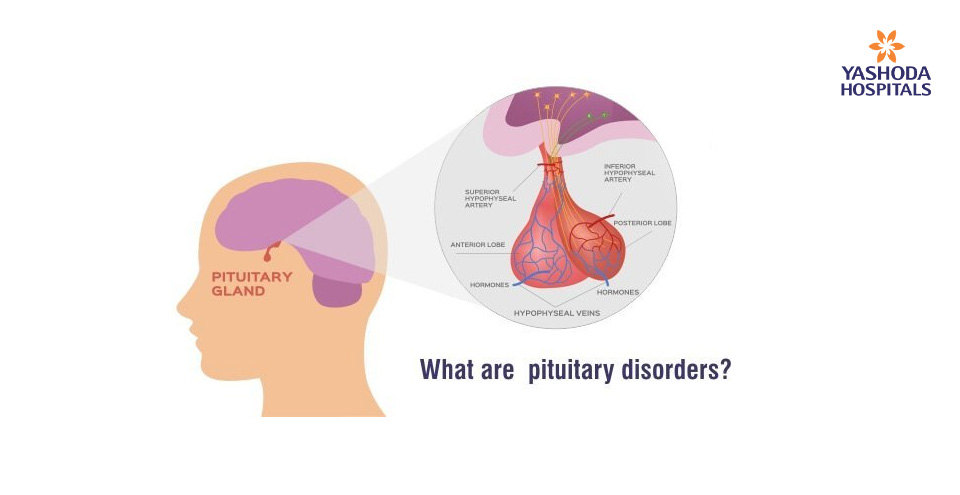
1. What are pituitary disorders?
2. Where is the pituitary gland located and what are its key functions?
3. What causes pituitary disorders?
4. What are the different types of anterior pituitary disorders?
5. What are the different types of posterior pituitary disorders?
7. What are pituitary tumours?
8. What is the prevalence of pituitary tumours?
9. What causes pituitary tumours? Are there any risk factors?
10. What are the signs and symptoms of pituitary adenomas?
11. Are pituitary tumours life-threatening?
12. What are the complications of pituitary tumours?
13. How are pituitary tumours diagnosed?
14. How are pituitary tumours treated?
15. How to cope with the side-effects of tumour treatment?
16. How to care and support a person with a pituitary tumour?
What are pituitary disorders?
Pituitary disorders are a group of hormonal disorders that result from chemical imbalances and are caused due to the derangement or poor functioning of the pituitary gland.

Where is the pituitary gland located and what are its key functions?
The pituitary gland is a tiny pea-sized organ located at the base of the brain.
It is part of the endocrine system, that controls the proper functioning of different hormones in the body. It is commonly known as the ‘master gland’ as it makes and stores several hormones. These pituitary hormones control the activity of other hormones in the body.
The pituitary gland has 2 parts: the anterior (front) and the posterior (back) parts, each producing a different set of hormones. Each of these hormones acts on different parts of the body and controls their proper functioning (refer Table 1)
Table 1. Pituitary hormones and their functions
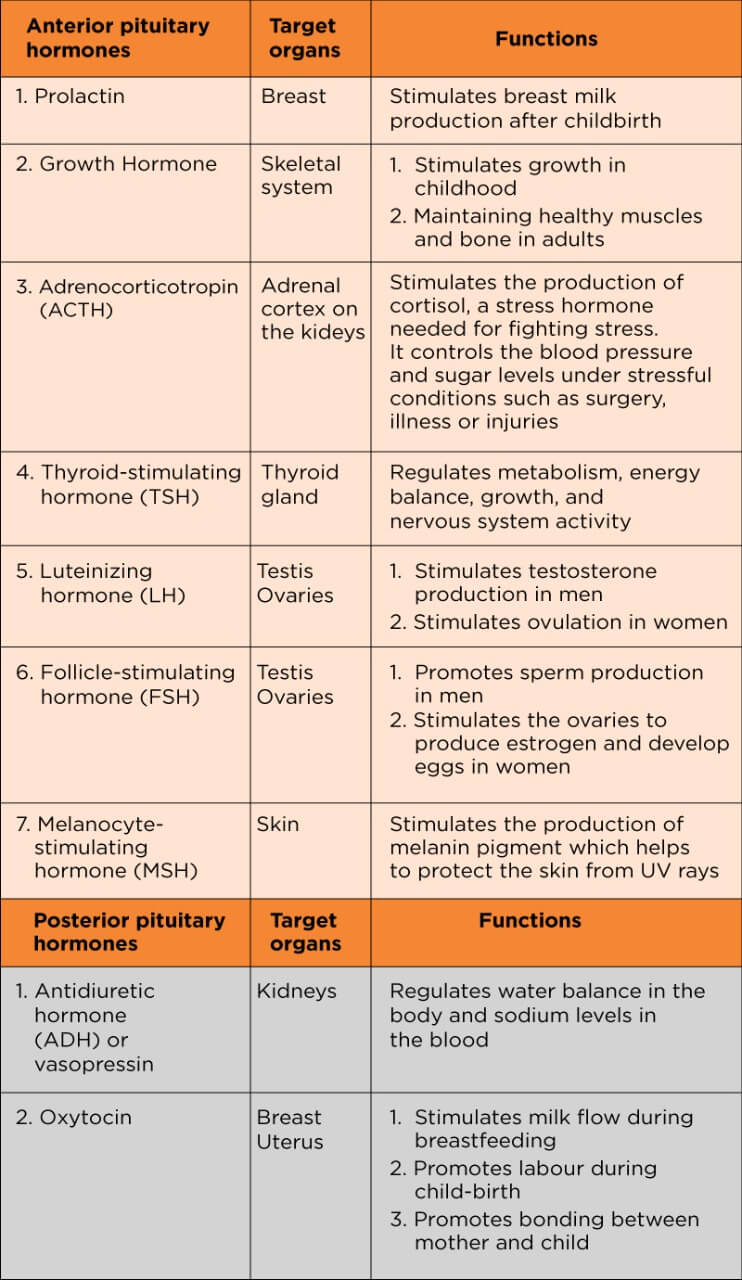
What causes pituitary disorders?
The most common causes of pituitary disorders include
- Tumour growth
- Head injury
- Birth defects
- Inherited genetic defects
- Low blood supply to the pituitary gland
- Previous history of pituitary disorders
- Iron overload
- Medication
- Radiation therapy in the head and neck region
What are the different types of anterior pituitary disorders?
Anterior pituitary disorders occur as a result of overproduction or underproduction of hormones secreted by the anterior lobes.
Disorders caused by over-production of anterior pituitary hormones
The disorders caused by overproduction of anterior pituitary hormones and their respective signs and symptoms are tabulated in Table 2. This Table also provides an overview of the diagnosis and management of these disorders.
Table 2. Disorders caused by over-production of anterior pituitary hormones
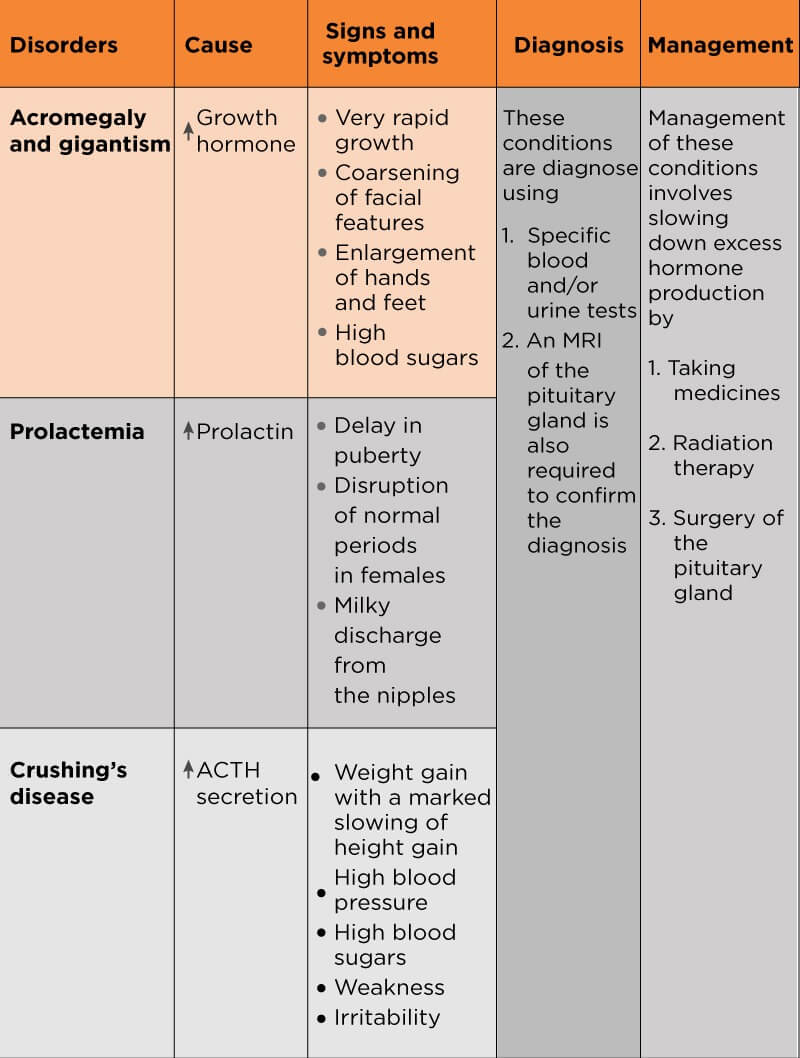
Disorders caused by under-secretion of anterior pituitary hormones
The disorders caused by under-secretion of anterior pituitary hormones and their respective signs and symptoms are tabulated in table 3. Table 3 also gives an overview of the diagnosis and management of hypopituitarism.
Table 3. Disorders caused by under-secretion of anterior pituitary hormones

What are the different types of posterior pituitary disorders?
Posterior pituitary disorders are caused by either under-production or overproduction of the ADH hormone. ADH helps the kidneys to prevent excess water loss through urine. Imbalance in ADH production can lead to the following disorders (table 4)
Table 4: Posterior pituitary disorders

What is hypopituitarism?
Hypopituitarism is a condition that results in a partial or complete loss of the anterior pituitary gland functions. Panhypopituitarism is a condition, characterized by damage to the entire pituitary gland. In such cases, the production of all pituitary hormones stops.
Causes
The most common cause of hypopituitarism is the growth of a pituitary tumour. Other causes may include head injuries, brain surgery, medication, and radiation therapy, etc.
Signs and symptoms
Tumours may cause eyesight problems.
The symptoms of hypopituitarism depend upon the hormones which are no longer being produced by the gland and vary depending upon the age of the patients.
Diagnosis
The following tests may be done to establish the diagnosis
- Blood tests and stimulation or dynamic testing to identify low levels of pituitary hormones
- Brain imaging using an MRI or CT scan to detect tumour or other pituitary gland problems
- Vision tests to determine if the pituitary gland is affecting eyesight
Management
- Hormone replacement therapy: Patients need to take life-long medications to control the symptoms. The doctor monitors and adjusts the medication dose periodically in all patients based on the patient condition
- Surgery or radiation treatment may be required in some patients
What are pituitary tumours?
Pituitary tumours are abnormal growths in the pituitary glands. They may cause overproduction or low levels of pituitary hormones. Most pituitary tumours are noncancerous growth and remain confined within the pituitary gland. These are known as an adenoma. Pituitary adenomas can be classified as 2 types based on their sizes
- Microadenoma, when the tumour size is <1 cm. Most pituitary adenomas are microadenomas
- Macroadenoma, when the tumour is >1 cm in size
Pituitary carcinomas (cancers) are very rare and mostly affects the elderly population. Pituitary carcinomas can spread to the brain, spinal cord or the bone surrounding the pituitary glands. In some patients, the pituitary adenoma can turn cancerous and spread to other parts of the body.
What is the prevalence of pituitary tumours?
A pituitary adenoma is the third largest cause of brain tumours, accounting for 10% of all cases. The global prevalence of pituitary adenomas is approximately 17%. Studies have reported the risk of pituitary tumours to increase with age, with maximum cases being diagnosed between 30 and 60 years.
What causes pituitary tumours? Are there any risk factors?
The cause of pituitary adenoma remains unknown. Genetic alteration is thought to play an important role in adenoma development.
Studies have shown that people with certain genetic factors such as multiple endocrine neoplasia, type 1 (MEN 1) are at increased risk of pituitary tumours.
What are the signs and symptoms of pituitary adenomas?
- Tumours can put pressure on the pituitary gland and the nearby structures. This can cause headaches and loss of side-visions
- As the tumour grows in size, it can damage the normal functioning of the gland and interfere with hormone production. Overproduction or hormonal deficiencies can cause specific signs and symptoms or sometimes a combination of them. For example, ACTH tumours exhibit signs and symptoms of Cushing’s syndrome.
Are pituitary tumours life-threatening?
If diagnosed early, pituitary tumours can be managed well. However, if left undiagnosed and untreated for a long period, such tumours can become large and affect the functioning of several organs of the body, causing blindness, hypertension, diabetes, osteoporosis, heart disease and death.
Evidence suggests the 5-year survival rate of pituitary gland tumours be about 82%. Survival rate also depends upon factors of
- Type of tumour
- Person’s age
- How far the tumour has spread in the brain or to other parts of the body
What are the complications of pituitary tumours?
The complications of pituitary tumours include
- Blindness
- Permanent hormone deficiency
- Pituitary apoplexy is a rare and serious complication that causes sudden bleeding of the pituitary tumour. It is an emergency condition and needs immediate treatment with medications or surgery
How are pituitary tumours diagnosed?
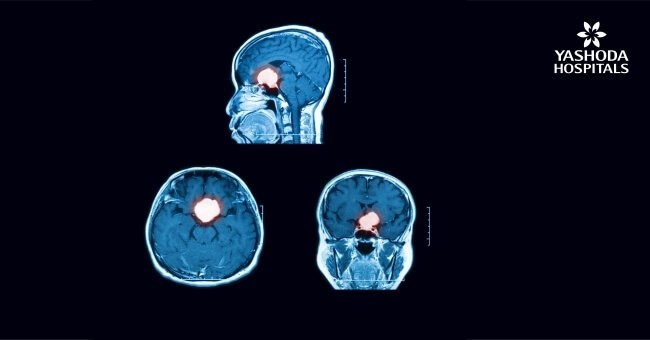
Diagnosis can be confirmed with the help of the following tests
- Blood and urine tests help to determine whether there is an overproduction of deficiency of hormones
- Biopsy: This involves removing a small number of cells and examining them under a microscope to check for abnormal growth
- Brain imaging: A CT scan or brain MRI scan can help the doctor to determine the size and location of the tumour
- Vision testing to understand if the tumour has caused eyesight problem
- Neurological exam: A set of questions and answers to check a person’s mental status and appropriate brain functioning controlling movement and coordination.
How are pituitary tumours treated?
Not all pituitary tumours require treatment. The choice of treatment depends upon the following factors of
- Type and size of the tumour
- If the tumour is making hormones
- If the tumour is obstructing vision or associated with other signs or symptoms
- If the tumour is localized or has spread to other parts of the body
- If the tumour has occurred for the first time or has recurred
- The patient’s overall health
The treatment team usually consists of a brain surgeon (neurosurgeon), endocrine system specialist (endocrinologist) and a radiation oncologist. Doctors use a combination of surgery, radiation therapy and medications to normalize hormone levels.
- Surgery: Surgery is required when the tumour presses on the optic nerve or leads to the overproduction of hormones. The Endoscopic transnasal transsphenoidal approach involves removing the tumour through the nose without making an incision. This is usually done when the tumour is small in size and no other part of the brain is affected by it. The Transcranial approach (craniotomy) is used for removing large tumours by making an incision in the scalp.
- Radiation therapy: This technique uses high-energy radiation to destroy tumour cells. It can be used alone or in combination with surgery.
- Medications: They help to limit excess hormone production and shrink certain types of pituitary tumours. Hormone replacement therapy in patients with reduced hormone production post-surgery.
- Watchful waiting: Many patients do not exhibit any symptoms and function normally without any treatment. In such cases, patients are advised only regular tests to keep a check on the tumour growth.
How to cope with the side-effects of tumour treatment?
Cancer treatment can be overwhelming in most patients. Here are a few tips which can help the patient to cope with the stress.
Physical side effects: Most cancer treatment is associated with serious long-term physical side-effects. It is advised to talk to the health care team openly regarding
- Pros and cons of treatment before starting therapy
- Newer or changes in existing side-effects and seek advice regarding the same
Emotional and social effects: Some patients may experience anxiety, depression, fear, sadness, memory loss and difficulty to deal with stress. Others might limit their social life.
- Visiting a counsellor or talking to a family member, friend or health care team member is encouraged
How to care and support a person with a pituitary tumour?
Family members and friends play an important role in providing both physical and emotional support to the patients. A caregiver can support a patient in several ways including,
- Accompanying the patient during hospital visits and talking to the doctor
- Giving medication and assisting during meals
- Helping in household chores and daily activities
- Helping manage symptoms and side-effects
- Provide emotional and financial support when needed
- Spending quality time and help cope with anxiety and depression
References:
- Pituitary disorders. The University of British Columbia. https://endocrinology.medicine.ubc.ca/endocrine-conditions/pituitary-disorders/. Accessed on April 20, 2020.
- Pituitary gland. Endocrine Society. https://www.hormone.org/your-health-and-hormones/glands-and-hormones-a-to-z/glands/pituitary-gland/. Accessed on April 20, 2020.
- Patel H, et al. Physiology, Posterior pituitary. NCBI. https://www.ncbi.nlm.nih.gov/books/NBK526130/. Accessed on April 20, 2020.
- Chapman IM. MSD Manual consumer version. https://www.msdmanuals.com/home/hormonal-and-metabolic-disorders/pituitary-gland-disorders/overview-of-the-pituitary-gland. Accessed on April 20, 2020.
- Pituitary disorders. Lab Tests Online. https://labtestsonline.org/conditions/pituitary-disorders. Accessed on April 20, 2020.
- Pituitary tumors. Mayo Clinic. https://www.mayoclinic.org/diseases-conditions/pituitary-tumors/symptoms-causes/syc-20350548. Accessed on April 20, 2020.
- Pituitary gland and pituitary tumors. AANS. https://www.aans.org/en/Patients/Neurosurgical-Conditions-and-Treatments/Pituitary-Gland-and-Pituitary-Tumors. Accessed on April 20, 2020.




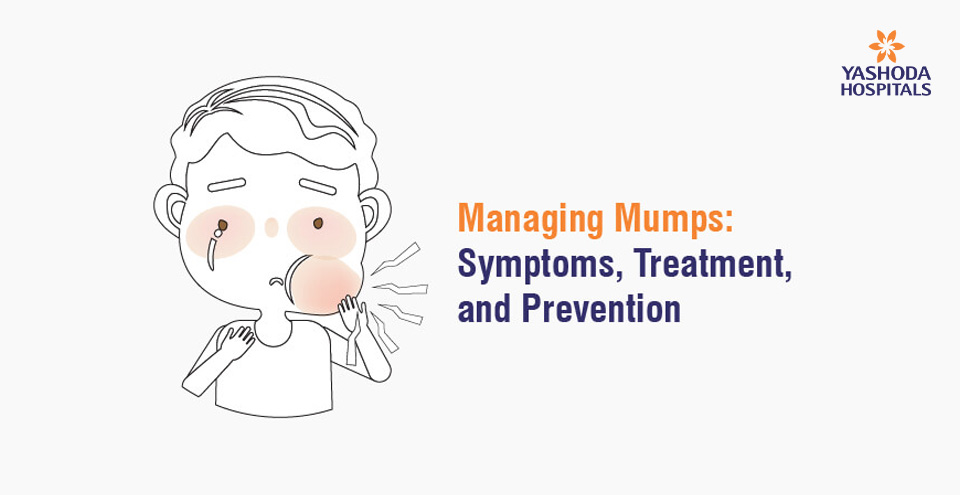





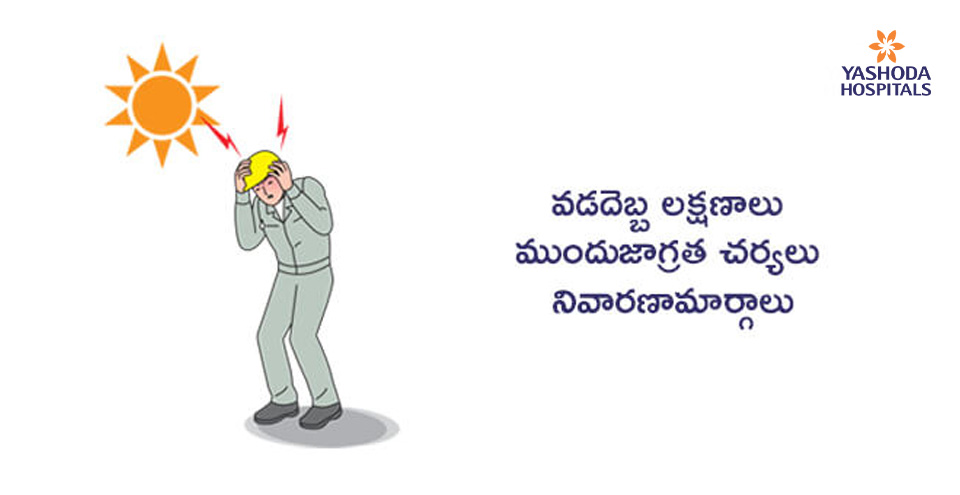

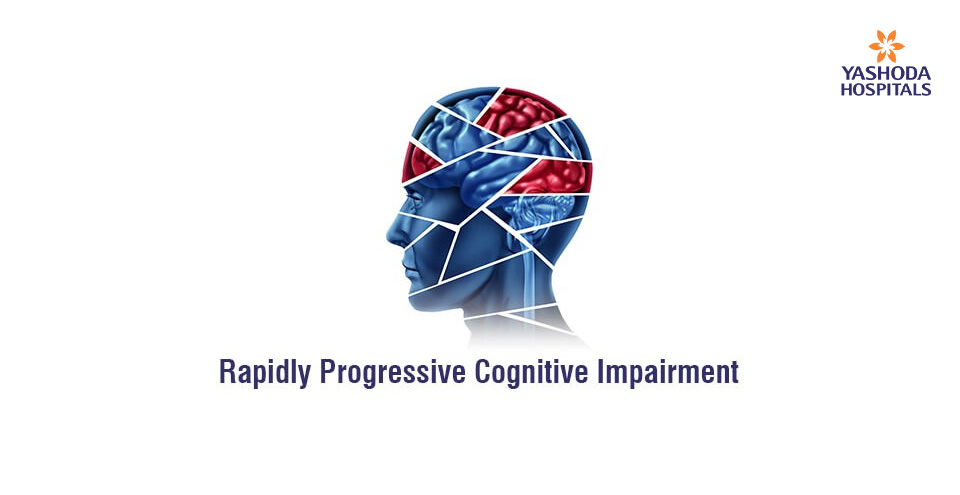

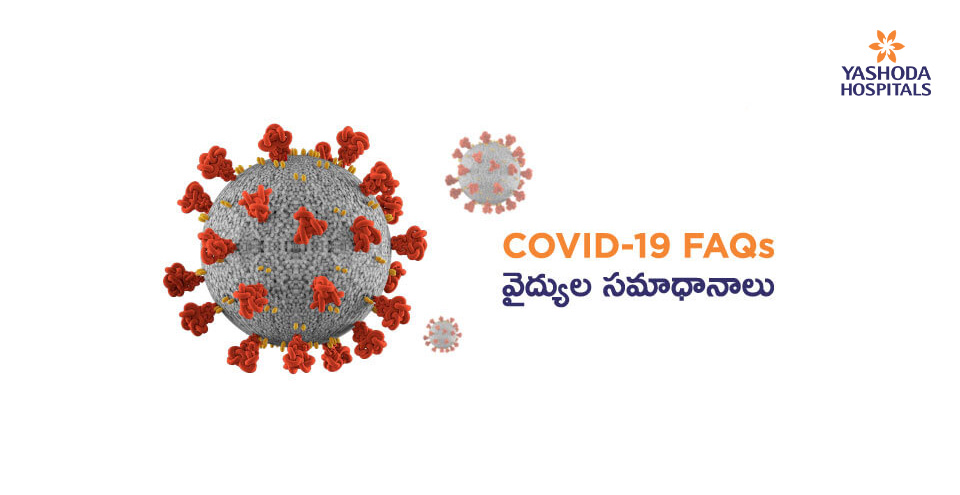
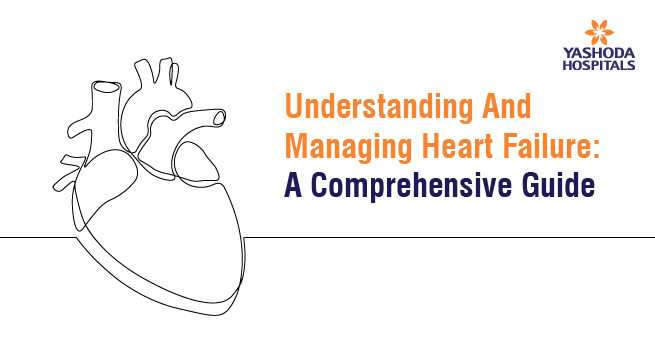



 Appointment
Appointment Second Opinion
Second Opinion WhatsApp
WhatsApp Call
Call More
More





